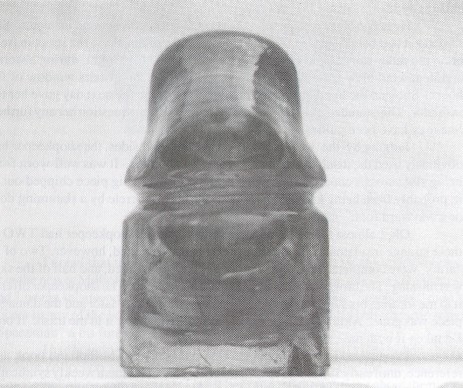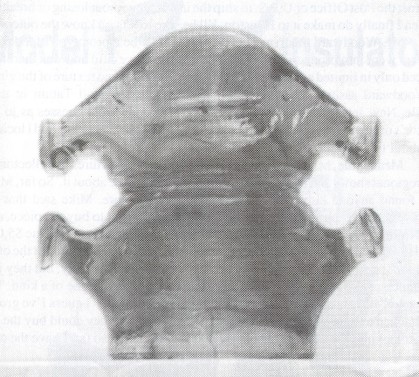A New Variety Of Insulator?
by Dean Hemphill, NIA #4759
Reprinted from "Crown Jewels of the Wire", April 1992, page 15
Many an insulator collector secretly dreams of discovering a new variety of
insulator, whether it be glass, porcelain, or some other material. Having a new
CD or U- or M- number assigned to the piece would make the find even more
satisfying. Sadly, at this late date, very few of us will have the chance to
experience the excitement of making that magic discovery. I'm one of the lucky
ones who just happened to be at the right place at the right time. Here is my
story.

Looks like a square-shouldered, heavy signal, doesn't it. Turn the page....
My new variety is shown in the accompanying photographs. As you can see, it's
a real oddball! I call it the "Spaceman", because it reminds me of a
robot from outer space that appeared years ago in an old black and white science
fiction movie on TV.
The piece is about 4-3/4 inches tall and about 4-1/2 inches across the
"arms". It is bluish-aqua in color, has a shallow (1/4 inch tall) inner
petticoat, and fits perfectly on the standard size North American threaded pin.
It's very crudely molded, with many surface swirls, lots of foreign matter in
the glass, and a slight underpour on the inner petticoat. It has no embossing on
it anywhere.
I found this strange insulator back about 1985 or 1986, sitting on
a shelf in a small antique shop in the beautiful Southern New Jersey farm
country. The nice lady who owned the shop told me that the piece had been
sitting on that shelf for years, and no one had given it a second look. Oddly
enough, she said that she sold quite a few of the "normal" insulators.
I liked the piece immediately, so I happily paid the $4.00 asking price. At the
time, I was fairly new to the hobby, so I had no idea that the piece was
anything special. Back then, my only reference was a 1974 Milholland book. This
insulator didn't appear in the book, but I didn't worry because Milholland
himself admitted that his book didn't include every existing type of insulator,
known or otherwise.
I asked the shopkeeper where she obtained such a strange
insulator. She said that it had been installed on some type of line that ran
along the street in front of an old three-story frame house she used to live in.
One night, during a storm, a violent wind blew the pole over, and it fell
through an upstairs window of the house. She said the linemen who came to repair
the line the next day gave her the insulator. This sounded a bit far-fetched to
me, but l didn't question her any further. She may have been pulling my leg.
Judging by the wear and tear on the base and sides, the shopkeeper had obviously
used the insulator for many years as a doorstop. It was well-worn from being
slid across a concrete floor. One of the arms has a big piece chipped out of it,
probably from being knocked over onto the hard concrete by a slamming door or a
wayward foot.
Oh, I almost forgot to mention something: the shopkeeper had TWO
of these strange insulators! The other one was badly damaged, however. Two of
its "arms" were completely missing, a third was badly damaged, and
half of the skirt was missing. The broken piece was priced at a mere $2.00. The
shopkeeper offered it to me for free, but I didn't take it. I visited the shop a
year later and the damaged piece was gone. Although I didn't ask, I assume she
threw it in the trash. If only I'd taken it with me... I continued to build my
collection using my old Milholland book as a reference, until early 1991. The
"Dallas Morning News" prints a weekly syndicated antique collecting
column. Someone at work who knows that I collect insulators (I still don't know
who) anonymously left me a copy of the column in which a reader asked about
insulator collecting and where to obtain more information. The article mentioned
"Crown Jewels of the Wire", the McDougalds' books, and the NIA, along
with some other regional Clubs. I immediately sent for a subscription to
"Crown Jewels of the Wire", a set of the McDougalds' books (with price
guide), and my NIA membership. I felt like I had finally graduated to the
"big time". I couldn't wait to read all of the information that would
be appearing in my mailbox. I also obtained a later copy of Milholland.

Introducing. . .CD 181.5
I noted that the "Spaceman" was not listed in the McDougalds'
books, or in the newer Milholland. I studied the pictures of the rare, one of a
kind pieces, and I began to suspect that there was a good reason that the
"Spaceman" didn't appear in any of the books. Perhaps it was rare? I
decided I'd better research the "Spaceman" a bit further.
I had bought
some insulators from Mike Guthrie, and I knew he had a huge insulator collection
and a head full of knowledge. I sent Mike the photos of the "Spaceman"
along with a letter asking if he could tell me anything about the piece. A few
days later, I received a phone call from an excited Mike Guthrie. He said he
looked at the pictures, and showed them to other collectors, and none of them
had ever seen an insulator even similar to mine. He called it "the find of
the decade" (his words), and insisted that I send the pictures to Woody
Woodward in Houston, which I did. Mr. Woodward agreed that the piece was a new
find. He asked me to bring it down to him so that he could inspect it,
photograph it, and properly document it. He also stated that he will most likely
assign a new CD number to the piece once he's actually seen it in person.
Unfortunately, I haven't had the time to make the drive to Houston (it's a seven hour trip each way)
and I don't trust the Post Office or U .P.S. to ship the insulator without
losing or breaking it. When I finally do make it to Houston, I'll be sure to let
you know the outcome.
Mr. Woodward theorized that the piece may be a prototype
of a design that never went into production, or one that was not successful and
was therefore produced only in limited numbers. Judging from the color and
texture of the glass, Mr. Woodward assumes that the piece was made by Whitall
Tatum in their Millville, New Jersey glass works around 1923. Woodward's guesses
as to the insulator's origin are quite believable, since nobody else has seen
one, and I located mine about twenty miles from Millville.
Meanwhile, Mike
Guthrie has been showing the pictures to collectors at many regional shows and
the National, hoping to learn more about it. So far, Mike hasn't found anyone
else who's seen this insulator before. Mike said that I'd probably receive phone
calls from other collectors offering to buy the piece, and he was right. After
seeing the photos, one West coast collector offered me $5,000 cash. However
enticing that amount of money seemed, I thanked him for the offer and turned it
down. I've been told by non-collectors that I'm crazy, but they just don't
understand. I've never owned anything before that was one of a kind. The
"Spaceman" is truly unique, I have no intention of selling it. I guess
I've grown very attached to him. Money is nice, but no amount of money could buy
the joy I get just looking at my unique insulator, and knowing that, so far, I
have the only one!
LATE BREAKING NEWS....I just received a call from Dean Hemphill. Boy, was he
excited with information regarding the "Spaceman" insulator. I have
been waiting months to share this great story with you readers, and now there
are more pieces of the puzzle to give you.
I was aware that there would be a show in north Texas in early March. I had
wanted to run the story in March, but the new insulator just didn't have a name
yet. I ran out of room in preparing the March issue and decided to wait one more
month. At the Metroplex Insulator show the" Spaceman" would have a
chance to make its way back to Houston so that N.R. Woodward could examine the
insulator in person.
Yes! A new CD has been assigned. CD 181.5!
Yes! There is a patent covering
its design.
Yes! A patent was granted to E.F. Shoenthaler on November 17, 1903.
Yes! Yes! There will be a follow-up story very soon with all of the details of
this late breaking news.
|
